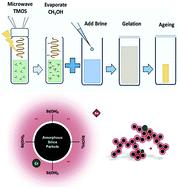当前位置:
X-MOL 学术
›
Environ. Sci.: Water Res. Technol.
›
论文详情
Our official English website, www.x-mol.net, welcomes your feedback! (Note: you will need to create a separate account there.)
Stabilization and solidification of brine water containing selenium, chromium, copper, and mercury utilizing a microwave enabled sol–gel process
Environmental Science: Water Research & Technology ( IF 5 ) Pub Date : 2021-3-2 , DOI: 10.1039/d1ew00081k Alex Kearns 1 , Meenakshi Bansal 2 , Theodore Kalbfleisch 1 , Aaron Keller 2 , Kirk Ellison 3 , Rajat Chauhan 4 , Mahyar Ghorbanian 1, 5 , Gautam Gupta 1
Environmental Science: Water Research & Technology ( IF 5 ) Pub Date : 2021-3-2 , DOI: 10.1039/d1ew00081k Alex Kearns 1 , Meenakshi Bansal 2 , Theodore Kalbfleisch 1 , Aaron Keller 2 , Kirk Ellison 3 , Rajat Chauhan 4 , Mahyar Ghorbanian 1, 5 , Gautam Gupta 1
Affiliation

|
To comply with the new regulations on coal-fired power plants, many treatment scenarios are inclining towards zero-liquid discharge (ZLD) technologies. Therefore, there has been a dramatic shift in the treatment approaches for managing effluents at coal-fired plants within the past decade. Traditionally, stabilization/solidification (S/S) ZLD technologies fall into two categories: cementitious and vitrification. However, neither approach offers the ideal solution for coal-fired power plants needing ZLD by S/S methods. Here, we report a novel proof-of-concept of a sol–gel encapsulation – chemical and physical – method using only one chemical: tetramethyl orthosilicate and the resulting materials are evaluated as an alternative S/S effluent treatment. We demonstrate that the concept of sol–gel encapsulation is an efficient method to solidify and chemically stabilize various brine waters and wastewater effluents from a midwestern coal-fired power plant that burns both bituminous and sub-bituminous coals. The encapsulated solids successfully retained positively charged contaminants during leaching analyses, while struggling to retain negatively charged contaminants. Based on the results shown, it is proposed that the negatively charged silicon dioxide network chemically fixates positively charged contaminants, leading to the retention of those contaminants. These results demonstrate that sol–gel encapsulation has the potential to be developed as an alternative S/S technique to meet the challenges of ZLD technologies. It is anticipated that the work presented will be a starting point for further development of S/S treatment with sol–gels derived from fly ash.
中文翻译:

利用微波溶胶-凝胶法稳定和固化含硒,铬,铜和汞的盐水
为了遵守关于燃煤电厂的新法规,许多处理方案都倾向于零液体排放(ZLD)技术。因此,过去十年来,燃煤电厂废水处理的处理方法发生了巨大变化。传统上,稳定/固化(S / S)ZLD技术分为两类:胶结和玻璃化。但是,这两种方法都无法为需要通过S / S方法实现ZLD的燃煤电厂提供理想的解决方案。在这里,我们报告了一种仅使用一种化学物质:原硅酸四甲酯的溶胶-凝胶封装的化学和物理方法的新颖概念验证,并将所得材料作为S / S废水的替代处理方法进行了评估。我们证明了溶胶-凝胶封装的概念是一种固化和化学稳定来自中西部燃煤发电厂的各种盐水和废水的有效方法,该发电厂既燃烧烟煤,又燃烧烟煤。包封的固体在浸出分析过程中成功保留了带正电的污染物,同时努力保留带负电的污染物。根据显示的结果,建议带负电的二氧化硅网络化学固定带正电的污染物,从而保留这些污染物。这些结果表明,溶胶-凝胶封装有可能被开发为替代Z / S技术的S / S技术,以应对ZLD技术的挑战。
更新日期:2021-03-17
中文翻译:

利用微波溶胶-凝胶法稳定和固化含硒,铬,铜和汞的盐水
为了遵守关于燃煤电厂的新法规,许多处理方案都倾向于零液体排放(ZLD)技术。因此,过去十年来,燃煤电厂废水处理的处理方法发生了巨大变化。传统上,稳定/固化(S / S)ZLD技术分为两类:胶结和玻璃化。但是,这两种方法都无法为需要通过S / S方法实现ZLD的燃煤电厂提供理想的解决方案。在这里,我们报告了一种仅使用一种化学物质:原硅酸四甲酯的溶胶-凝胶封装的化学和物理方法的新颖概念验证,并将所得材料作为S / S废水的替代处理方法进行了评估。我们证明了溶胶-凝胶封装的概念是一种固化和化学稳定来自中西部燃煤发电厂的各种盐水和废水的有效方法,该发电厂既燃烧烟煤,又燃烧烟煤。包封的固体在浸出分析过程中成功保留了带正电的污染物,同时努力保留带负电的污染物。根据显示的结果,建议带负电的二氧化硅网络化学固定带正电的污染物,从而保留这些污染物。这些结果表明,溶胶-凝胶封装有可能被开发为替代Z / S技术的S / S技术,以应对ZLD技术的挑战。

























 京公网安备 11010802027423号
京公网安备 11010802027423号